WHALE TAIL® Grants fund projects that support experiential education and stewardship of the California coast and its watersheds. Highlighted below are examples of some of our grant recipients over the many years of the program. See a full list of all past grantees on our grants map.
You can support the WHALE TAIL® Grants Program by purchasing a WHALE TAIL® License Plate or by donating to the Protect Our Coast and Oceans Fund on the California state tax form.

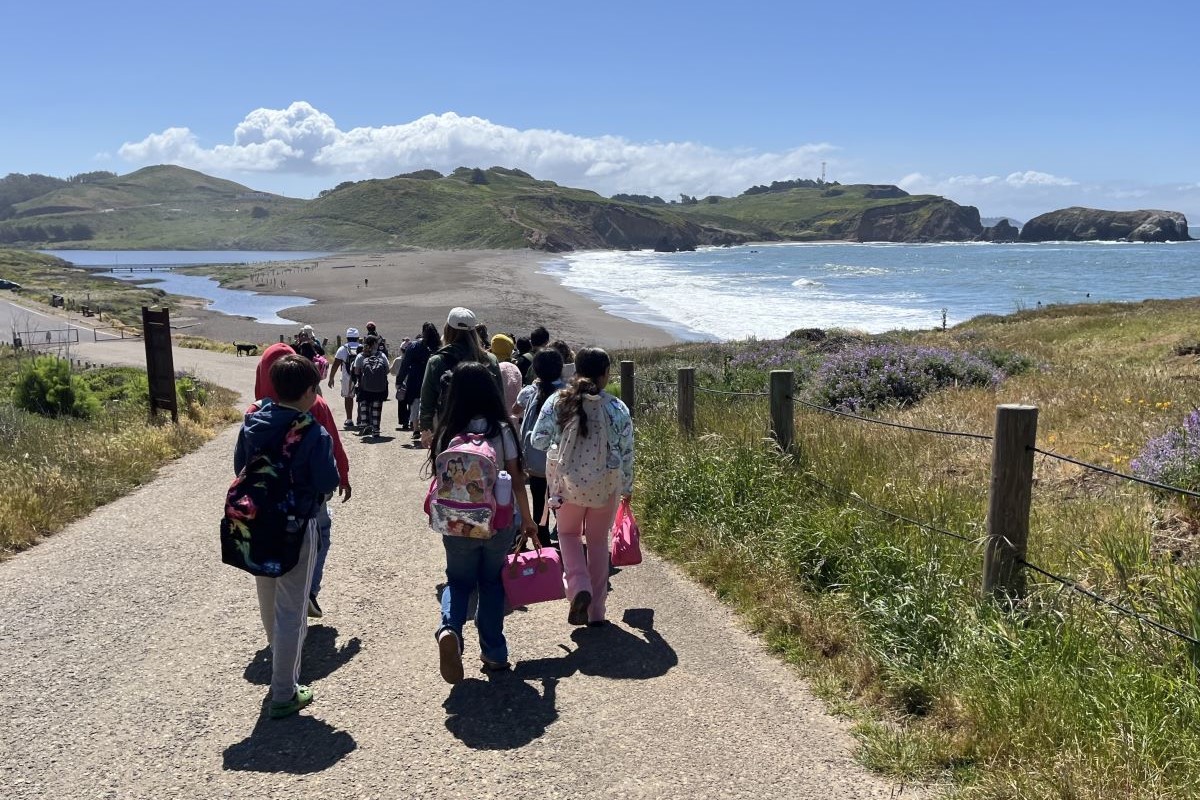
It was a beautiful, sunny day at Rodeo Beach with KIDS for the BAY. Two classes from Michelle Obama Elementary in Richmond came out on an ocean field trip to apply hands-on science learnings from classroom workshops and a bay habitat field trip as part of the Watershed Action Program. KIDS for the BAY received a WHALE TAIL® grant to engage eight 3rd through 5th grade classes from Richmond and San Pablo in watershed stewardship and ocean ecology.
KIDS for the BAY educators engaged youth in using their senses, learning about coastal plants and animals, and cleaning up trash from the beach. A highlight was a beach scavenger hunt where groups searched for something natural to closely observe. Students got to share out their discoveries, including algae, mussel shells, a brown pelican feather, and by-the-wind sailors! It was a full day of fun and coastal connections.
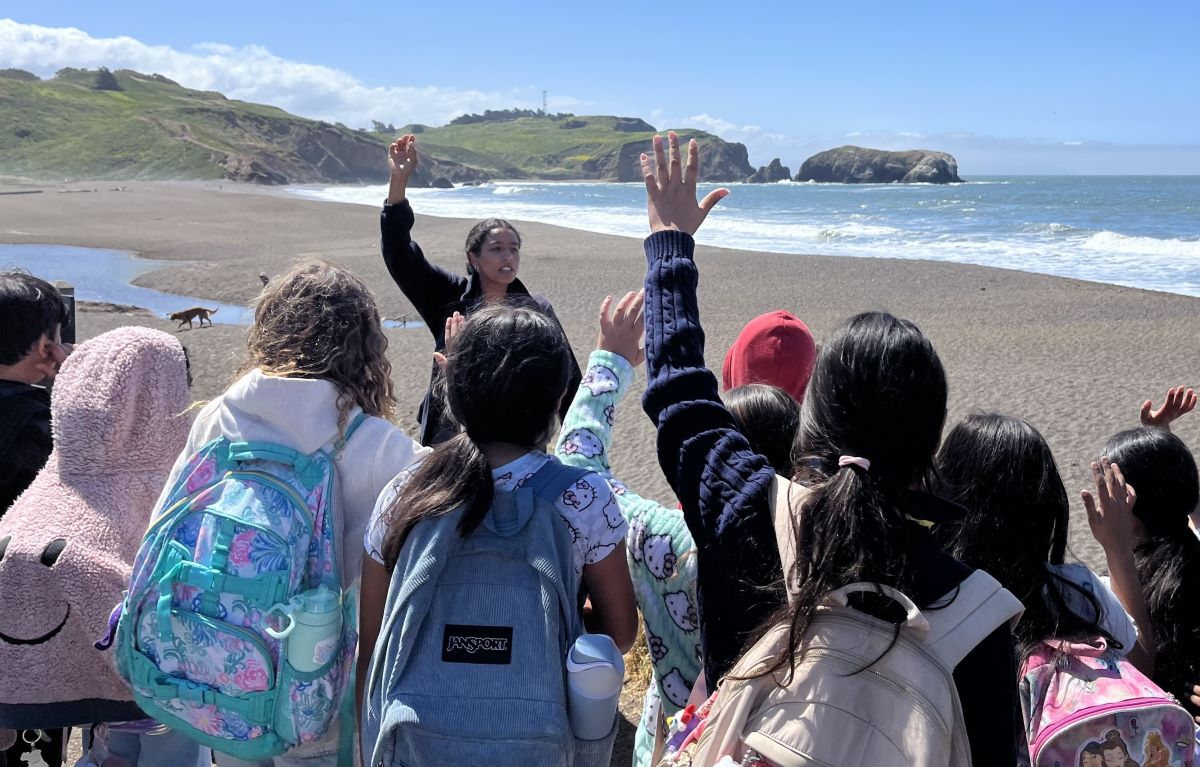
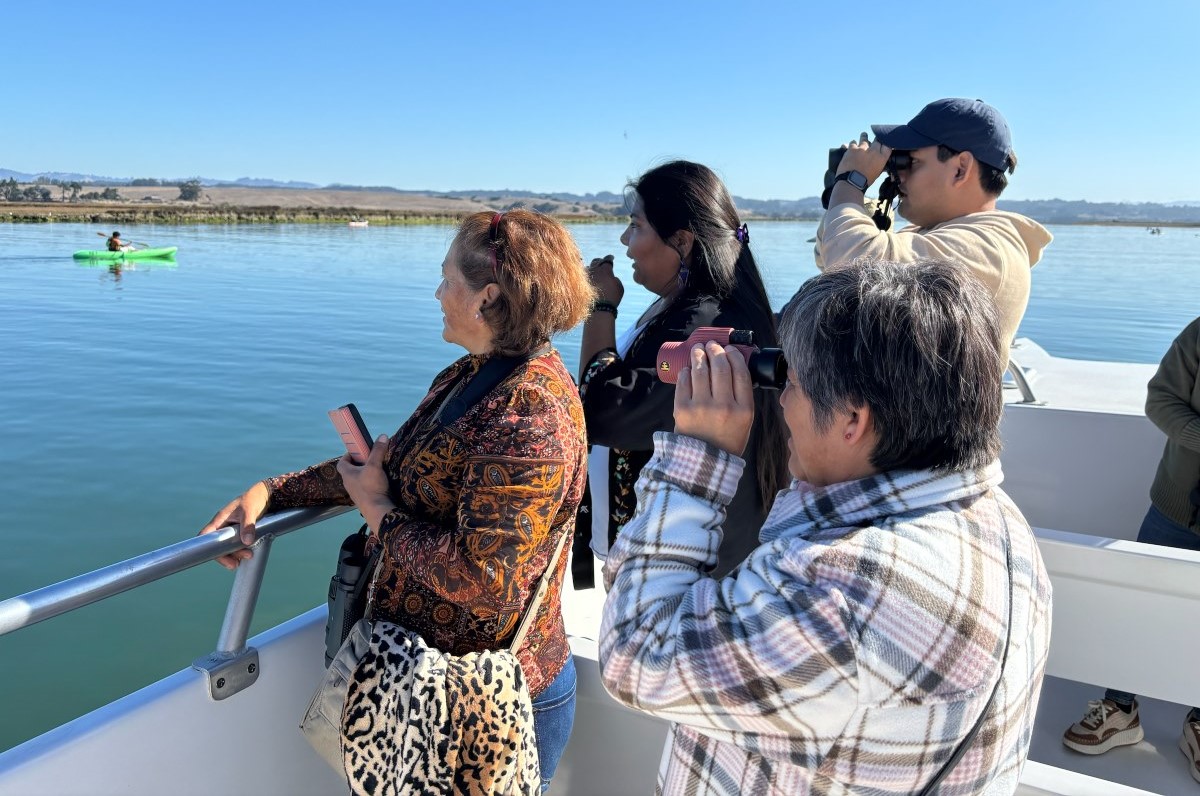
A WHALE TAIL® Grant supported Bird School Project to provide bilingual and culturally-relevant birding programs, with a focus on Latino and Spanish-speaking participants. Guided boating trips through Elkhorn Slough introduced intergenerational families to the rich diversity of migratory birds along the Pacific Flyway, while community birding events across Watsonville and Salinas created inclusive spaces for community members to experience local birding and outdoor activities.
Participants engaged in special guest presentations, guided discussions on conservation, bird identification and community science activities (including a Bird Lotería guide!), and storytelling. By drawing connections between bird migration and human migration, families were able to share about their own migration journeys and see their stories reflected in nature. This sense of belonging and stewardship has resulted in continued participant engagement beyond these trips, with many joining habitat restoration efforts, community events, and field trips through other local organizations and partners.
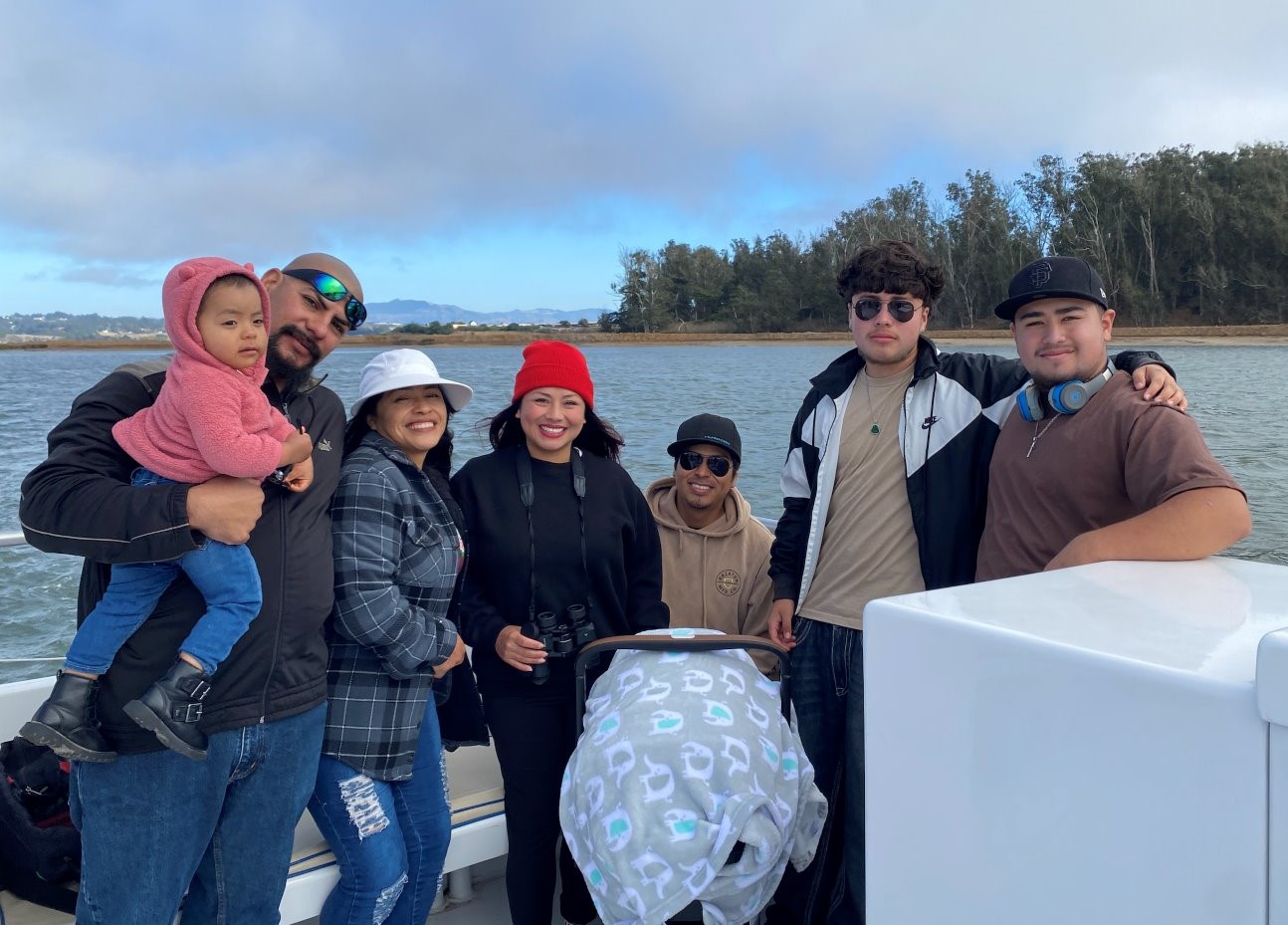
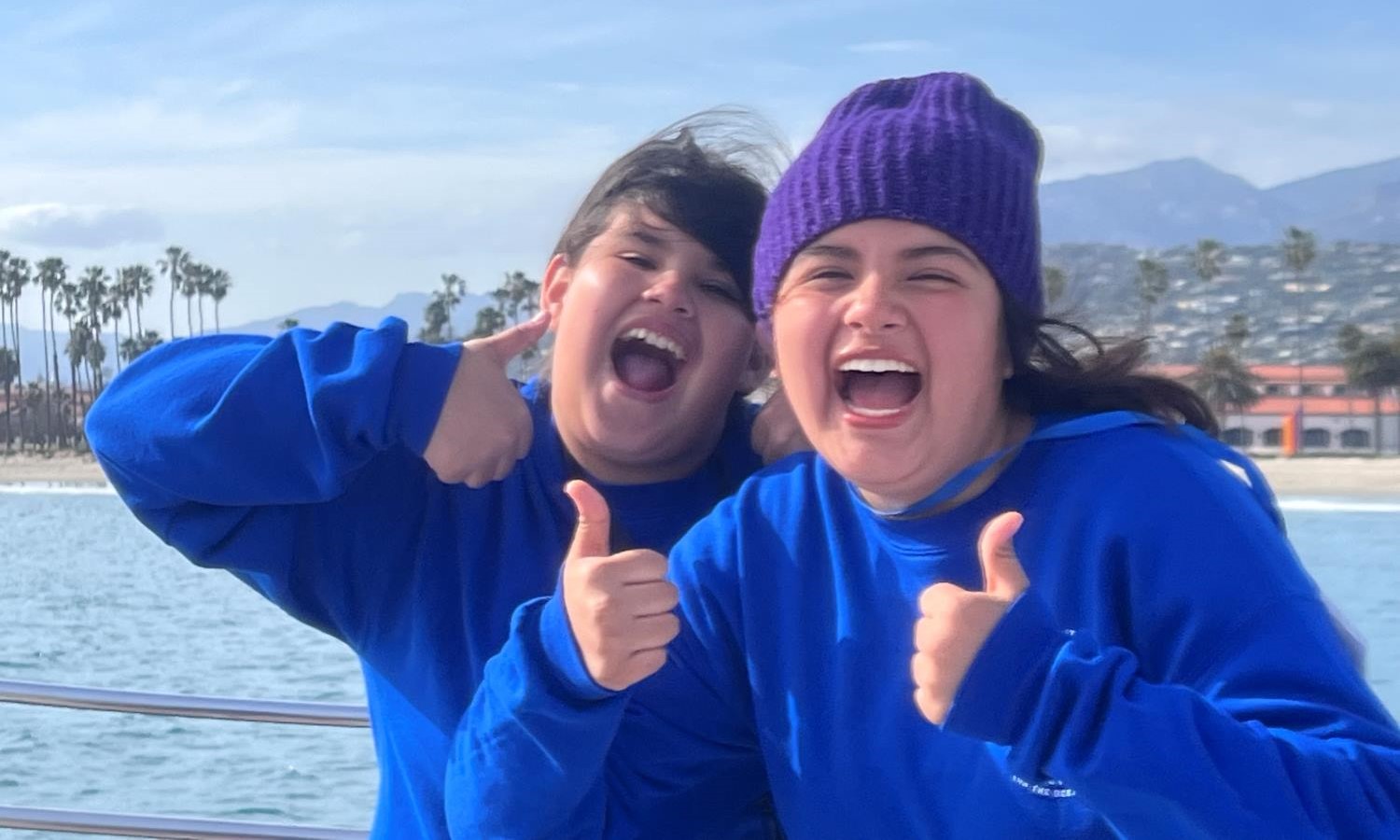
With support from a WHALE TAIL® Grant, the Fernandeño Tataviam Band of Mission Indians is organizing Traveling Tataveaveat: Áhëvëve mëmët (Traveling Tataviam Lands, On the Ocean Shore) to introduce youth to traditional Fernandeño Tataviam cultural and natural sites through fun, educational experiences. Youth engage with outdoor educators and naturalists to gain knowledge of local conservation efforts, while also gaining leadership skills, peer mentoring opportunities, and personal growth in culturally appropriate practices. In early 2024, youth visited Aquarium of the Pacific to observe marine life, they toured UC Santa Barbara to learn about educational opportunities, swam in the ocean at Leadbetter Beach, and explored the Santa Barbara Channel via boat. In March, Tataviam and Chumash Tribal Elder, Alan Salazar, shared traditional stories, his knowledge about tomols (traditional ocean canoes), and the importance of access to water as a cultural and natural resource. Youth made abalone shell necklaces with materials provided by Mr. Salazar, and they learned about cultural and natural resource preservation at the Santa Barbara Museum of Natural History.
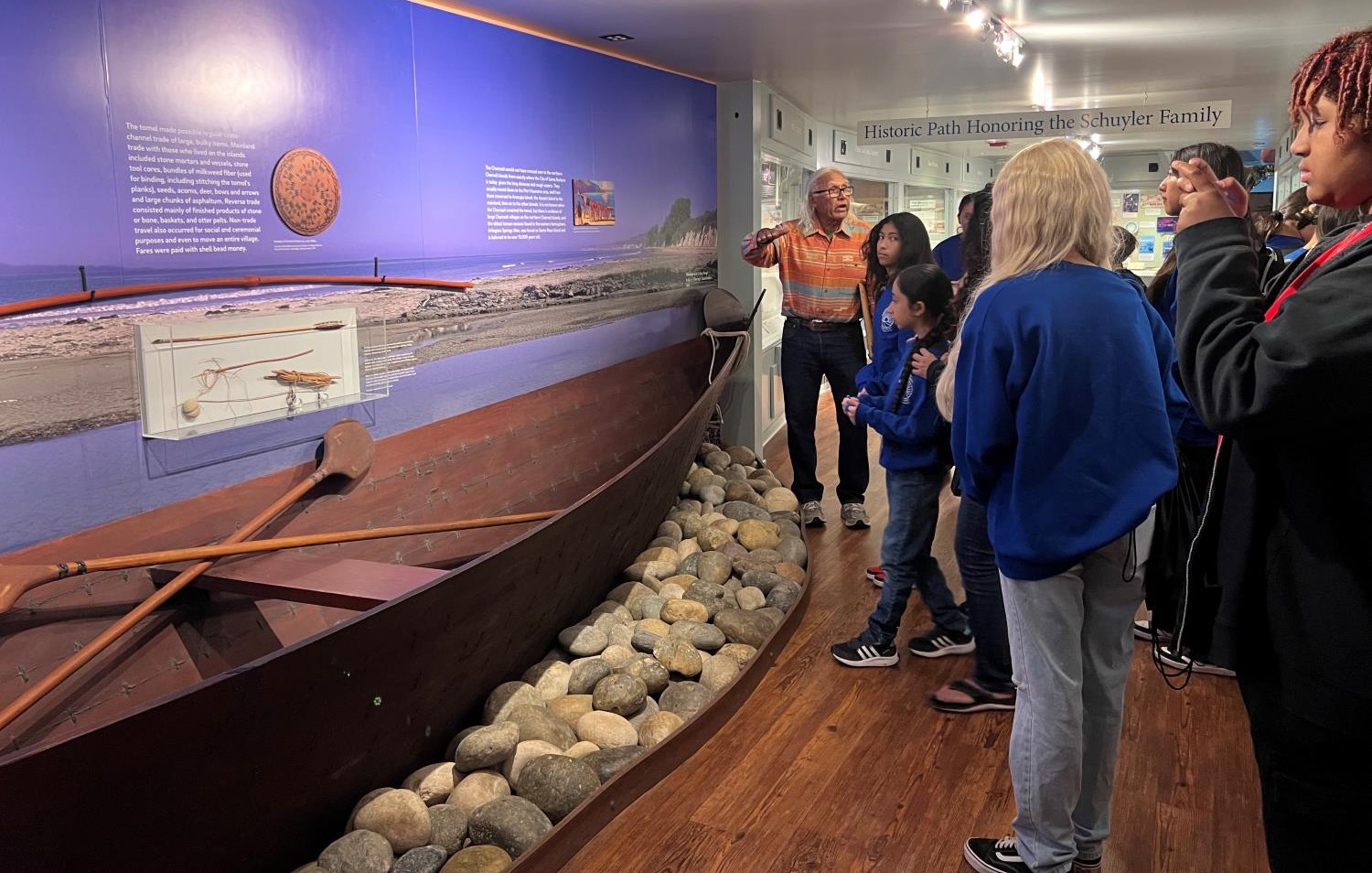

A WHALE TAIL® Grant supported Paddle for Peace to provide a free, Sunday morning beach recreational program with participants recruited from BIPOC communities of San Diego. The program included an educational component to teach students about the coast, inspiring them to return as stewards or pursue a job in coastal conservation. Along with ocean safety instruction, beach recreational activities such as surfing, boogie boarding, beach volleyball and soccer were offered for students to participate in if comfortable, with additional alternative beachside recreational activities available. The grant also supported an end of session family celebration, and a community-wide beach event for Juneteenth and Father's Day.
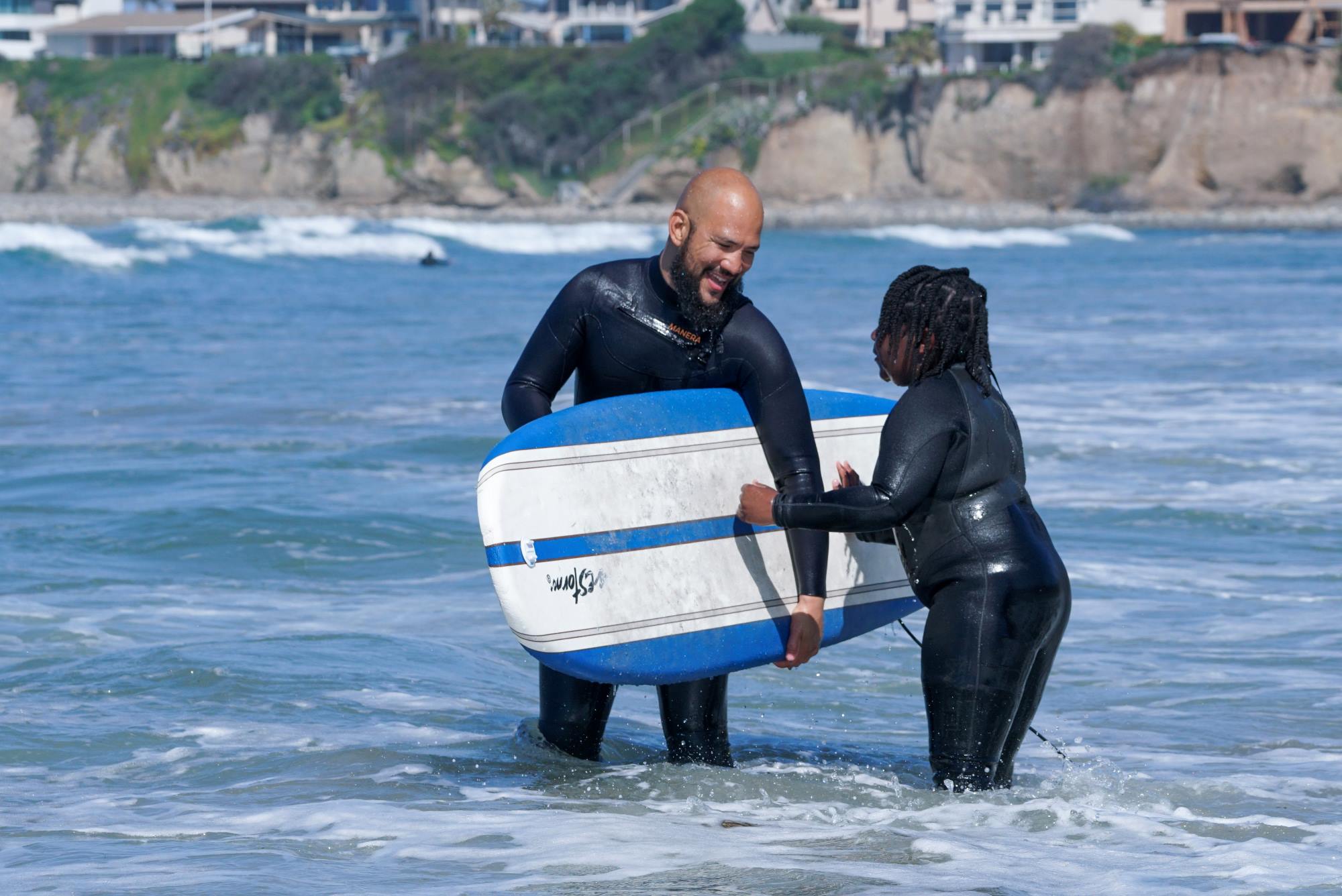
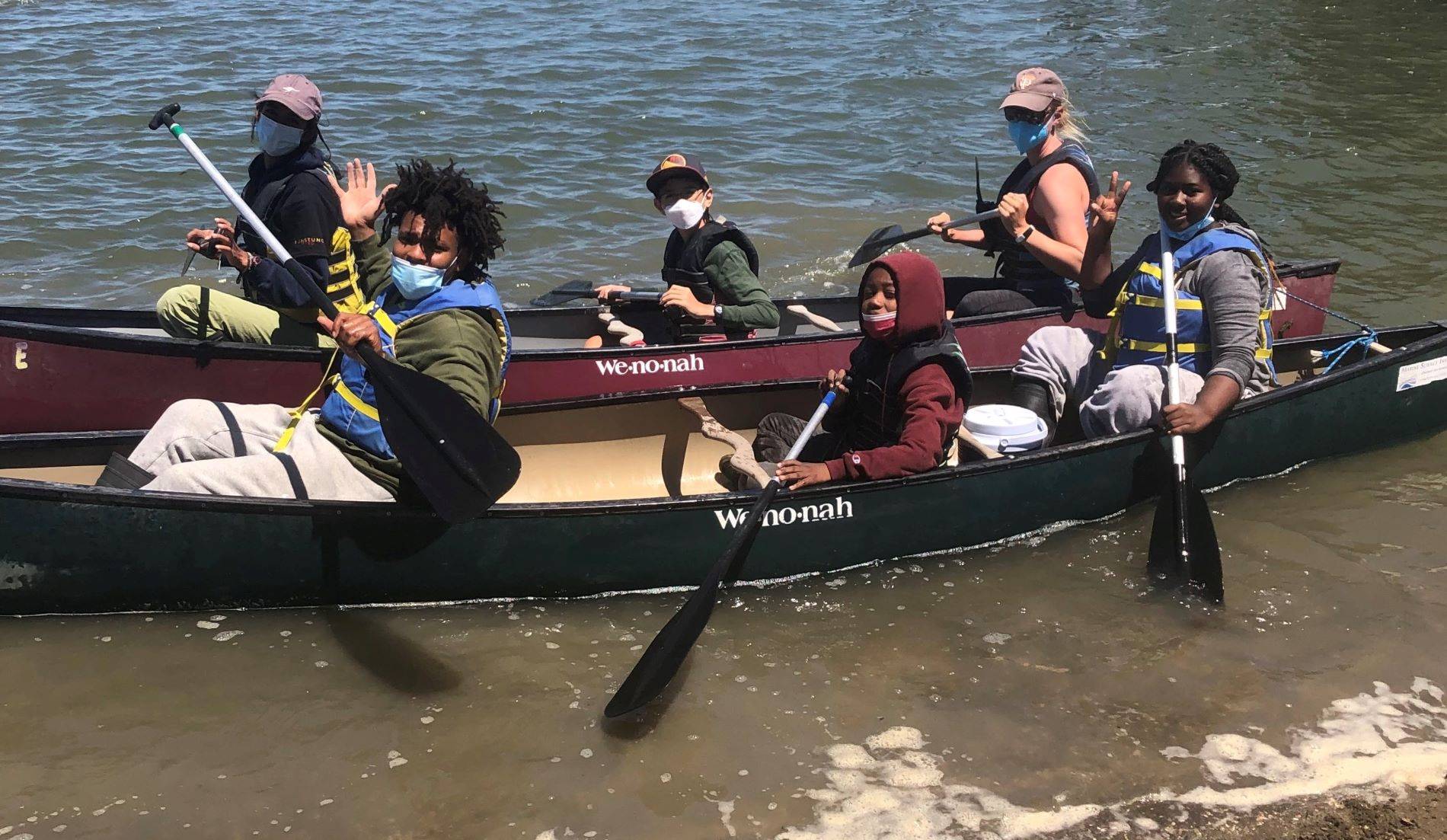
A WHALE TAIL® Grant supported summer camp for East Oakland middle and elementary school students with Camp Acta Non Verba. The six-week camp experience was jam-packed with fun and learning. The younger kids received swimming lessons at Mills College. They visited Crab Cove Vistor Center and played in the water at Crown State Beach. The Marine Science Institute brought their mobile aquarium to camp and shared knowledge about leopard sharks and other fish and the adaptations that help them survive in the bay and ocean. Then campers went to Aquarium of the Bay where they saw many more marine animals up close.
Older campers, known as Leaders-in-Training, learned how to sail at Alameda Community Sailing Center. They had a day of exploration and fun at Pacifica Beach, and then volunteered with Save the Bay at their native plant nursery and took part in a shoreline cleanup to care for the coast that they had been enjoying. Leaders-in-Training also paddled the bay with Marine Science Institute's Canoes in Sloughs program where they learned about coastal wetlands, and they went swimming at Cull Canyon and Don Castro Regional Recreation Areas.
Sailing lessons will continue during the school year and the grant will support camp again in 2023.
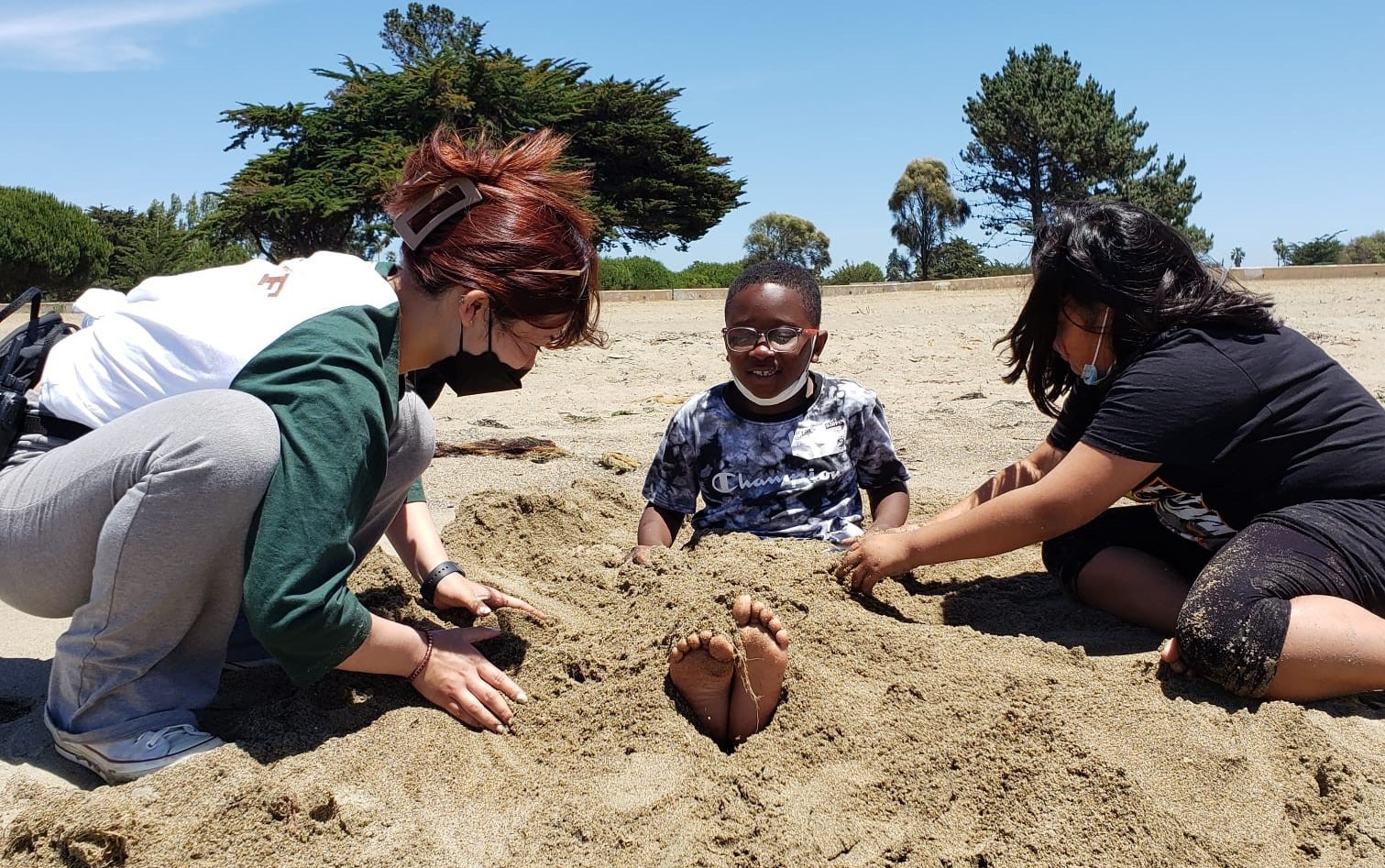
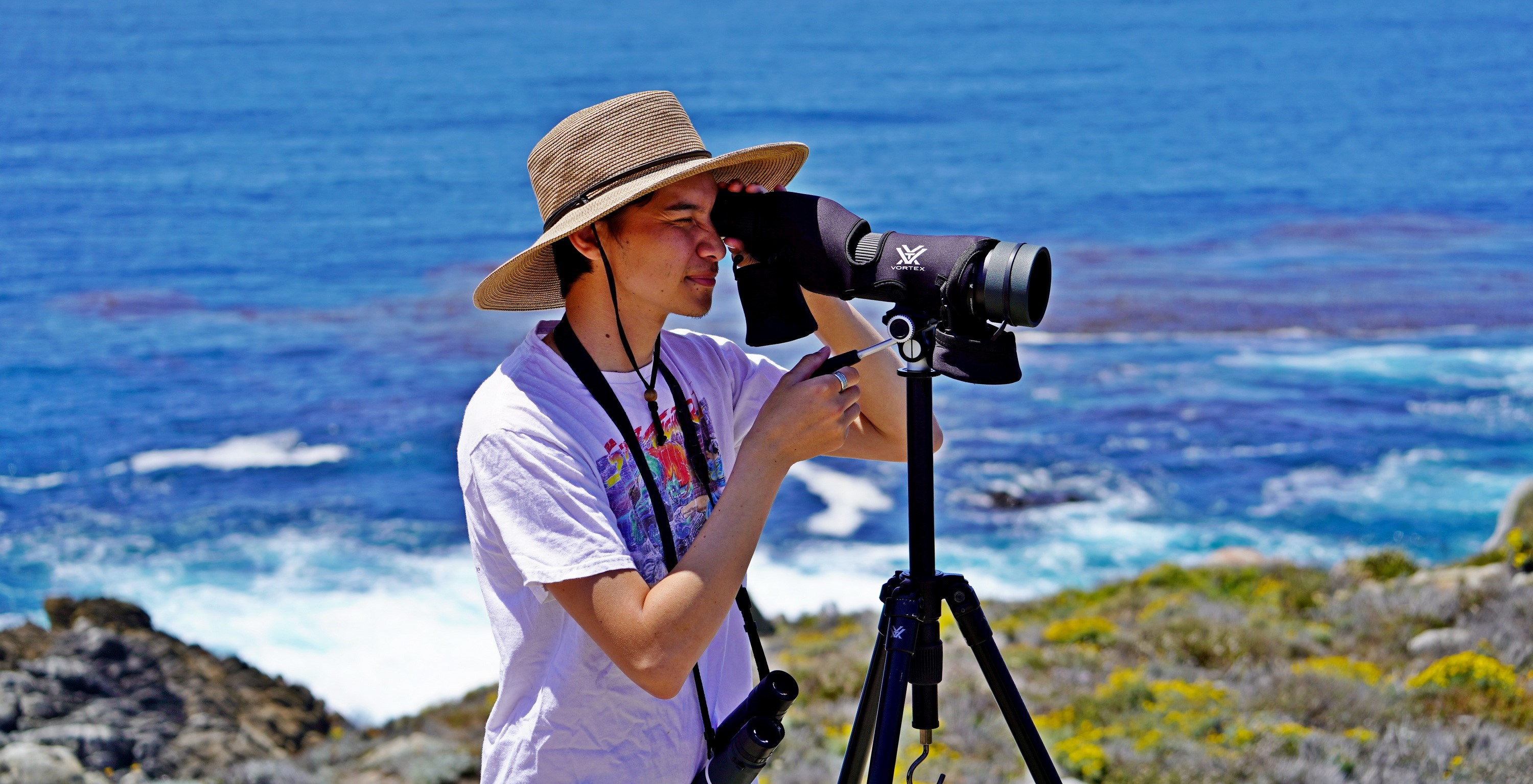
A WHALE TAIL® Grant is supporting a paid summer internship with Monterey Audubon Society focusing on the Black Oystercatcher. Intern Miguel Alvarado reflects on his experience:
"My name is Miguel Alvarado and I currently attend California State University of Monterey Bay as a third year student majoring in Environmental Studies. In early 2022, I was offered the opportunity to become an intern for the Monterey Audubon Society working alongside the Audubon Environmental Advocate and my personal mentor, Amanda Preece. As an intern, I am observing the Black Oystercatcher, a locally nesting shorebird, in order to collect progressive data to add to the previous 10 years of monitoring. This entails monitoring multiple oystercatcher territories and observing how the public uses these areas in order to reveal inhibiting factors to the birds' nesting success. I have become competent in my skills of educating the public, and have learned local regulations in order to provide the most accurate information. So far, this summer I have attained a multitude of skills; within my experiences I have acquired ways of communicating with the public, bird surveying techniques, and other analytical skills. This position is paving the way for a successful future in research within the scientific field that I am exploring. A goal of mine is to achieve a PhD with an environmental focus. Alongside obtaining my PhD, I would love to follow a path in developing Environmental Policy at a local level. As a first generation, Hispanic researcher from the Los Angeles area, I strive to reach a point where I am able to inspire individuals who are just like me, to reach their dreams of research and achieving a higher education."
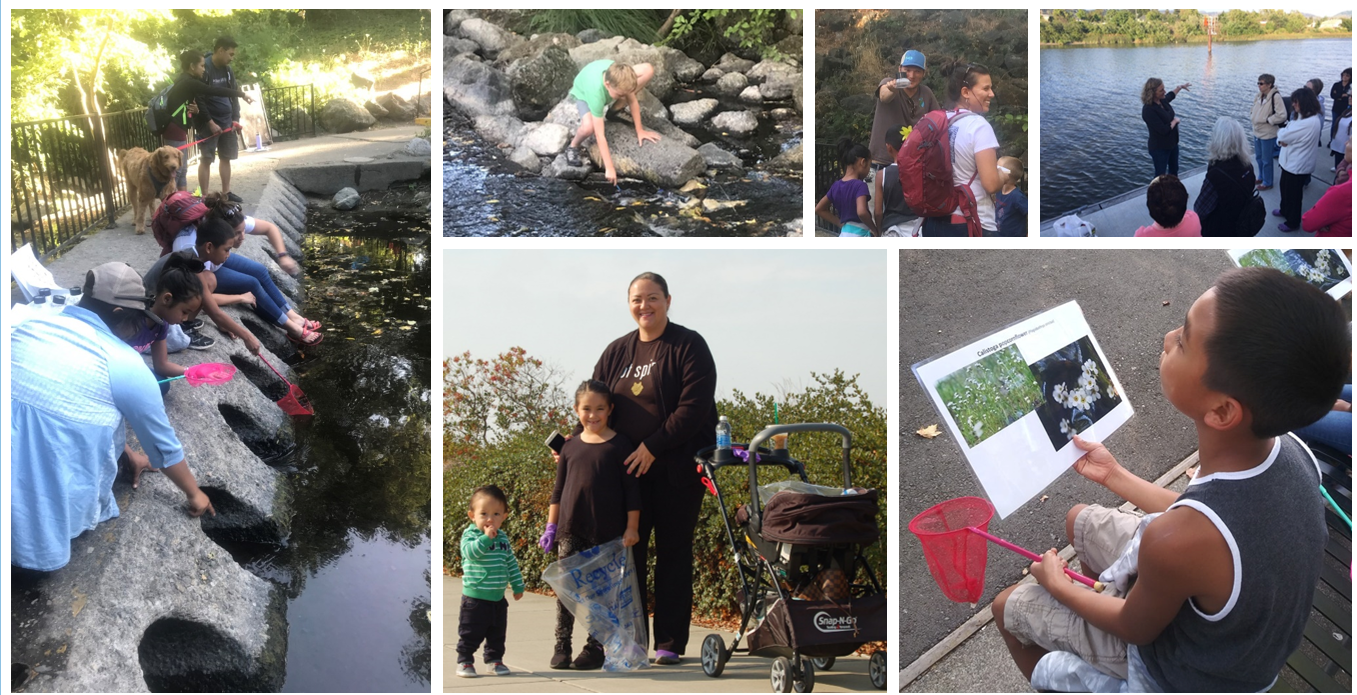
As part of a WHALE TAIL® Grant-funded project, the Napa County Library developed the H2O Superheroes Project to provide local families with community involvement opportunities focused on watershed conservation, stewardship, and climate change. The project included increasing the number of English and Spanish childrens books about coastal and marine environments; allowing library patrons to check out birding kits (including binoculars, guide books, and checklists) and cleanup kits (including a bucket, litter grabber, and gloves); holding storytimes focusing on taking care of local watersheds; offering guided watershed hikes, native planting events, and birding walks along local waterways; and much more. Library staff formed and strengthened partnerships with multiple community organizations to offer a total of 84 programs throughout the term of the grant, all while dealing with wildfires, power shut-offs, and a global pandemic (when they quickly shifted to virtual and distanced programming).
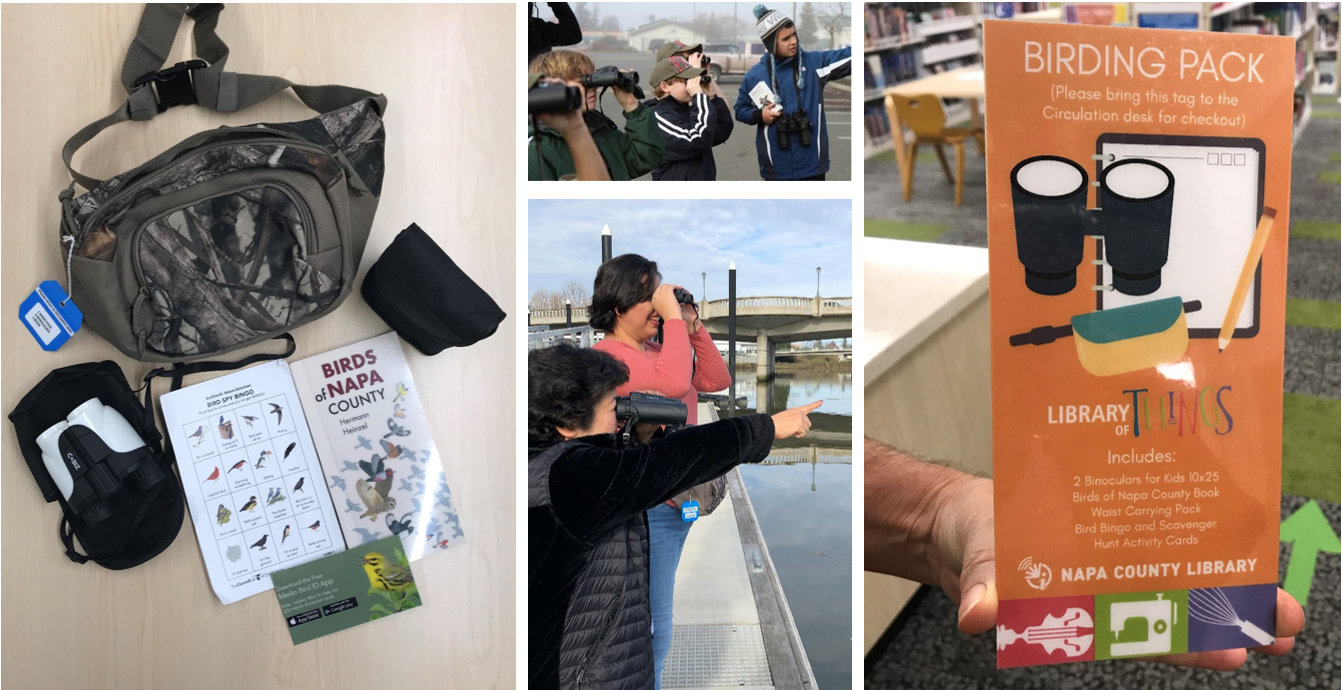

|
As part of a WHALE TAIL® Grant-funded project, YES Nature to Neighborhoods' Winter Camp took place this February in the Marin Headlands. Among those attending were eight youth in leadership positions helping with coastal conservation presentations to younger campers. One youth leader alumnus held a formal role as a Trip Leader during the weekend camp. Campers engaged in a wide range of activities from educational presentations to connecting with and kindling a love of the coast while hiking and playing on the beach under the sun. The weekend included healthy physical recreation activities, team-building, and learning about the effects of microplastics and microfibers on our marine and coastal habitats. Even the gorgeous sunny weather in mid-February provided a reference point for discussions of climate change and coastal conservation.
YES Nature to Neighborhoods' WHALE TAIL® Grant is also supporting other programming, including a "Marine Debris
Action Team" at Point Reyes National Seashore. YES strives to cultivate both youth and adult leaders in Richmond and
surrounding West Contra Costa County who lead healthy connected lives; motivate change in their neighborhoods; and
inspire a safe, thriving community.


|
The WHALE TAIL® Grant-funded "Creeks to Coast: A Watershed Science Program" presented a six-week watershed education and restoration curriculum
and a three-day coast field trip to 6th-8th grade students at five Klamath and Salmon River schools in Siskiyou County.
A collaboration between the Salmon River Restoration Council, the
Mid Klamath Watershed Council, and the Karuk Tribe's
Department of Natural Resources, this project taught students about the connections between their local creeks and
rivers and the Pacific Ocean, as well as the challenges facing these different environments. They learned about ocean
and estuary ecology, human impacts on the environment, and Karuk storytelling. They took part in habitat restoration
and river cleanups, and experienced camping at Patrick's Point State Park with hikes, tidepooling, and whale watching.
They visited Humboldt State University's Marine Lab and the Sumeg Yurok village with the Yurok Tribe.
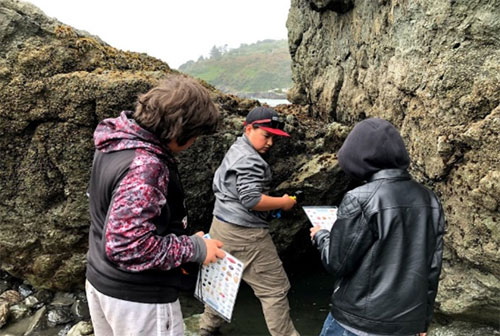
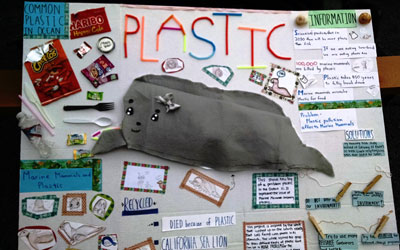
|
Ocean
Ambassadors is a middle school program letting students read the actual medical files of real patients at
The Marine Mammal Center as part of a year-long study
of marine mammals and ocean health. Through learning about real seals and sea lions (and visiting some in person) that
were affected by human actions, youth become inspired to learn what people can do help protect the ocean environment
and the wildlife that depend on it. This program includes lessons, classroom resources, and teacher training all provided
free of charge by The Marine Mammal Center in the San Francisco Bay Area (and Hawai'i). At the end of the school year,
enthusiastic student representatives come together at a "ConservationCon" to present conservation action projects they
developed.

|
Real Good Fish (a project of the nonprofit Social and Environmental Entrepreneurs) operates the
Bay2Tray program,
which provides local fish to school districts to use in their lunches. But the program also has an educational component
called Fishermen in the Classroom, run in partnership with the Monterey Bay National Marine Sanctuary. A WHALE TAIL®
grant funded commercial fishermen and fisherwomen to make 25 presentations at nine elementary schools in Santa Cruz, Monterey,
and San Benito counties. They spoke to the children about their jobs, the ocean, and the value of sustainable seafood.
An educator from the Sanctuary came too and talked about ocean stewardship. The children learned about their adventures
at sea, what their jobs are like, and how to make ocean-friendly food choices.
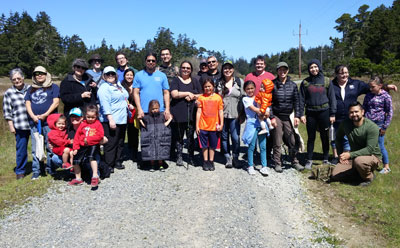
|
In Del Norte County not too far from the Oregon border, Tolowa Dunes Stewards is using a WHALE TAIL® grant for their project, "Developing Youth,
Tribal and Community Leaders." TDS hosts youth volunteer groups to remove non-native vegetation from Tolowa Dunes
State Park so native dune plants can thrive; they host native plant walks and invasive plant removal events for
the local community; and they collaborate with multiple generations of tribal members of the Tolowa Dee-ni' Nation.
Activities with the tribal members include how to find and make traditional vine tea from the dune forest,
restoration and education programs for tribal youth, and leading field programs in partnership with the Tolowa Culture
Department. Sometimes these programs even inspire creative writing! And they have also inspired teens to keep coming back and to make their own
video. TDS receives funding through a partnership
with the nonprofit Friends of the Dunes and has recently been able to leverage the WHALE TAIL® funds to receive
much more government grant money to restore more habitat and help native wildlife like the Western snowy plover.
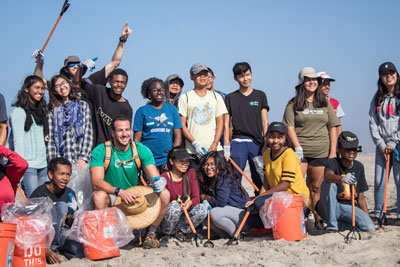
|
Outdoor Outreach offers
adventure-based learning experiences to teens in San Diego County who
normally lack access to outdoor areas. With help from a WHALE TAIL® grant, over 240 youth
were able to take part in environmental education and stewardship programs on the San Diego
County coast. Some of the activities for different groups included: kayaking at the San Diego
Bay National Wildlife Refuge; tidepooling at Cabrillo National Monument; helping clean up trash
at Border Field State Park during Tijuana River Action Month; and learning about watersheds and
how pollutants flow downstream, while also going surfing and learning stand up paddle boarding.
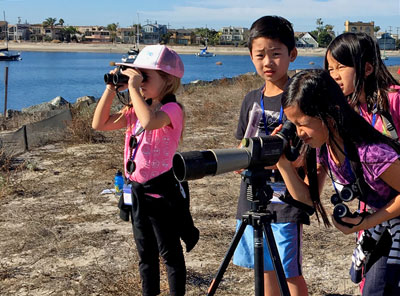
|
San Diego Audubon Society recently
finished a project supported by a WHALE TAIL® grant combining the creativity of third-graders with
the protection of endangered California Least Terns. The San Diego students participating in "Sharing Our
Shores: Mission Bay" learned about the coastal habitats supporting Least Tern nesting areas, as well as
threats to these shorebirds including habitat loss, pollution, off-leash dogs, and human disturbance to
their nesting areas. Then they designed signs to raise public awareness and reduce interference with the
nesting birds. Winning designs were turned into permanent signs installed at the beach, and all the rest
were displayed at "Love Your Wetlands Day" at Mission Bay. Each class also visited Mariner's Point in
Mission Bay Park for an educational field trip and to help remove invasive species and prepare the site
for the Least Tern nesting season.
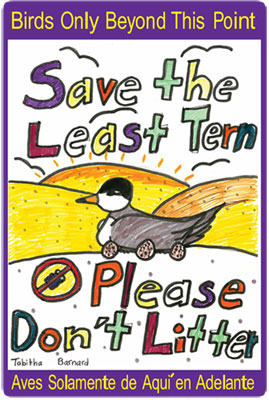

|
Healthy Coastal Communities is a project of Groundswell Coastal Ecology, bringing together Santa Cruz youth,
adult community volunteers, government agencies, and restoration professionals to foster
coastal stewardship and improve habitat at the seashore. With help from a WHALE TAIL® grant,
500 Santa Cruz area students at Title I elementary schools and high school occupational programs
are participating in Groundswell's five-step ecological restoration curriculum, which includes:
lessons on coastal biodiversity, native seed harvesting and plant propagation, restoration
planting, making scientific illustrations, and monitoring the habitat restoration outcomes.
Native plants are grown at greenhouses right at the schools, and then the students help plant
them at places like Seabright Beach and Natural Bridges State Beach. Hundreds of adults from
the area pitch in at community work days to help out too. The students also make paintings of
the native plant species on small wooden signs and install them by their new plants for everyone to see.

|
Action Network in Gualala, California
received a WHALE TAIL® grant for a "Coastal Connections" environmental education program for
children from northern Sonoma and southern Mendocino counties, many of whom were from rural tribal
reservations and low-income housing. Action Network provided summer-long programming over
two years, plus monthly activities during the school year, and took the children on educational trips
to the local beach, coastal prairie, and streams where they covered many topics such as coastal geology,
marine debris, native species, and local Pomo culture.
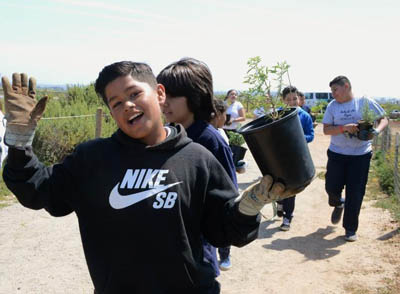
Photo: Ocean Connectors/Anna Mar |
Ocean Connectors uses environmental education
about migrating marine species to inspire and connect youth in National City (south San Diego
County) with marine science and conservation. In the fourth grade, students study the endangered sea turtles
that live in San Diego Bay while learning about pollution prevention and visiting the Living Coast Discovery
Center in Chula Vista. In the fifth grade, students learn about the migrating California gray whale as well
as topics related to sustainable seafood, and they go on a naturalist-led whale-watching trip. And in the
sixth grade, they study migrating birds and their ecosystems and also learn about the impacts of pollution
and habitat loss. The six-graders' outdoor experience is to help restore habitat, remove litter, and observe
waterfowl in the South San Diego Bay National Wildlife Refuge.
The Ocean Connectors program also includes a unique, bilingual, cross-border "knowledge exchange" in which
students trade artwork, writing, or short videos about their animals with other children who live in Nayarit,
Mexico, near where the animals migrate, reinforcing that they are all connected by the same ocean.
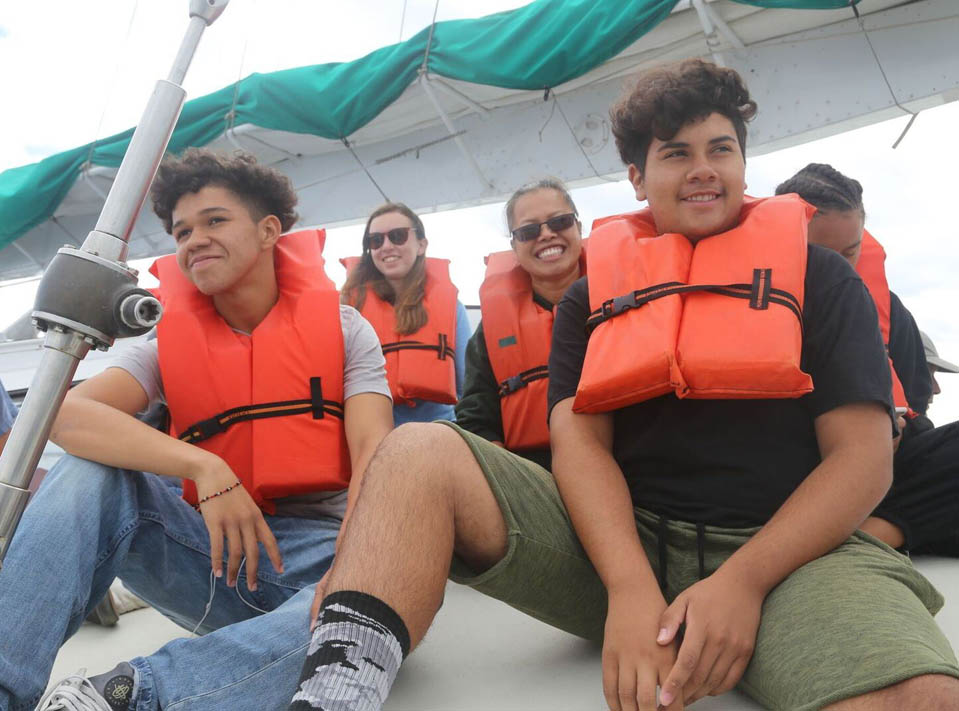
|
The Ship2Shore
program of Algalita Marine Research and Education
educates youth about the health of coastal waters and inspires them to address the problem of plastic
pollution in the ocean. With support from a WHALE TAIL® grant, 116 students from Long Beach and
other nearby cities participated in real-world research to measure the health of East San Pedro Bay by
collecting water and sea floor samples, identifying marine life, and counting and mapping floating plastic
debris. Several thousand more students were also reached through live satellite broadcasts from onboard
the research boat, assemblies back at school, and an interactive blog. Participating teens followed up
their research expeditions with community action projects to reduce plastic waste such as installing a
water station at school so students won't need to use plastic water bottles on campus anymore. One Long
Beach youth even won an honorable mention for a video submitted to C-SPAN urging the US government to address the issue of plastic
pollution.
Both WILDCOAST and LA Waterkeeper received WHALE TAIL® grants to bring youth to southern California's Marine Protected Areas to explore offshore waters by boat and become citizen scientists. (MPAs are underwater parks protecting the natural resources of that area.)
WILDCOAST recruited middle and high school students from groups like San Ysidro Girl Scouts, the La Jolla Band of Luiseño Indians, and schools in urban San Diego and Chula Vista, taught them about marine ecology and the MPAs of San Diego County, and then took them aboard chartered fishing boats they used as "floating labs" so the youth could collect data on water quality, plankton, fish, and human uses.
LA Waterkeeper worked with the Sherman Indian Museum and Sacred Places Institute to bring student
"ambassadors" from Sherman Indian High School in Riverside to take part in the MPA Watch program
monitoring the Marine Protected Areas in LA County for any boating or fishing activities and then
presenting their findings to their classmates. LA Waterkeeper's program also included coastal education
workshops on the school campus and developing a coastal stewardship curriculum incorporating Native
American traditional ecological knowledge and traditional sustainability practices.

|

|
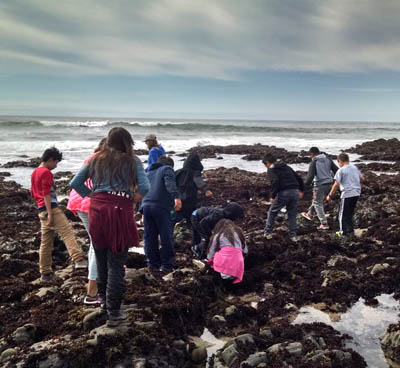
|
"Carrots is the roots!" exclaims an instructor who goes by "Lando" to a group of kids from East Palo
Alto having lunch at Vida Verde Nature Education's
farm. The farm includes a beautiful vegetable patch
that's going to provide them with some of their dinner each night, a yard with chickens who provide their
eggs every morning for breakfast, and goats they get to milk. (They even get to make cheese from the milk.)
As they finish up their food, Lando enthusiastically tells them about recycling, reusing, and composting,
and then each of them takes a turn sorting their lunch trash accordingly. We're visiting because we especially
want to see what comes next—a short bus ride to the San Mateo coast where another instructor who goes
by "Ms. Currant" leads a tidepooling exploration. The students we tag along with will also visit a sandy
beach after that. Vida Verde hosts a different group of kids each week during the fall and spring, they're
all Bay Area students from urban schools who attend for free, they're nearly all children of color, and none
of them would have otherwise been given the opportunity for an overnight outdoor education program. A WHALE
TAIL® grant is helping cover the cost of groups like this to attend the three-day coastal environmental
education program at Vida Verde.
| — |
Sylvie Lee Grants Program Coordinator |
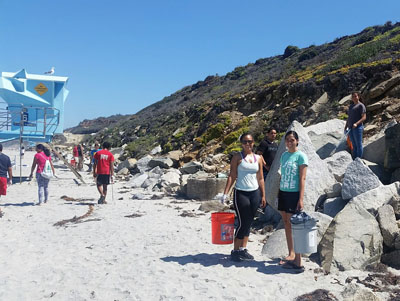 |
California has many Adopt-A-Beach® coordinators who are ready to
work with community volunteers wanting to help keep our beaches clean. Two of those coordinating
organizations, Heal the Bay in Los
Angeles and I Love A Clean San Diego,
have received WHALE TAIL® grants to run extensive, innovative, educational Adopt-A-Beach®
programs offering a lot of extra elements. For instance, both groups deliver educational presentations
about ocean pollution causes and solutions for volunteers before their cleanups. Both groups collect and
track data on the litter collected. In San Diego, volunteers can adopt inland canyons with creeks that
drain to the ocean. ILACSD also stocks supplies at a number of beaches so any visitor can conduct a
spontaneous "do-it-yourself" cleanup. In Los Angeles, underserved schools receive transportation stipends
so their students can learn, explore, and clean up at their beaches. Los Angeles volunteers can also
show up to popular monthly "Nothin' But Sand" cleanup events. Anyone in southern California who wants to
join the thousands of people already participating in these Adopt-A-Beach® cleanups is welcome to
contact either organization to learn how to participate.
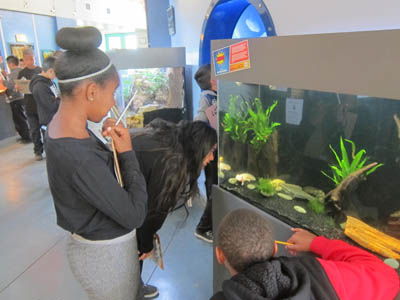 |
Groundwork San Diego - Chollas Creek
developed the Chollas Creek Climate Action Challenge for youth in southeastern San Diego
with support from a WHALE TAIL® grant in our new climate change education category. The program
taught students about greenhouse gases, global climate change, ocean acidification, and rising sea
temperatures; the green sea turtles that live in San Diego Bay and how climate change and ocean pollution
affect them; the benefits of urban canopies in absorbing carbon dioxide; and how to reduce energy
consumption at home. After they conducted home energy audits, they unplugged unused electrical devices
that still consume power ("energy vampires!"), calculated the savings, and made presentations to their
families. The students also had the opportunity to grow native plants and visit the
Living Coast Discovery Center in Chula Vista
to observe the sea turtles and other marine life, study water chemistry, and explore the Bay.
 |
Return of the Natives is the education and outreach program
of the Watershed Institute at Cal State Monterey Bay. RON has received a number of WHALE TAIL® grants over
the years to support teaching students of all ages about native plants and habitat restoration as they collect
and grow seeds and install native plants in sandy dunes near Monterey Bay. Most recently, RON received funding for
working with children and their parents in Salinas to teach them about their personal connection to the local
watershed and how litter in their schoolyards and neighborhoods ends up in the creeks and ultimately in Monterey Bay.
They learned about pollution prevention at school, did field studies and a cleanup at a local creek, and continued
their studies at the beach where the Salinas River ends up. In a special activity, their parents received bilingual
lessons and information about outdoor nature and stewardship activities they can do with their children.
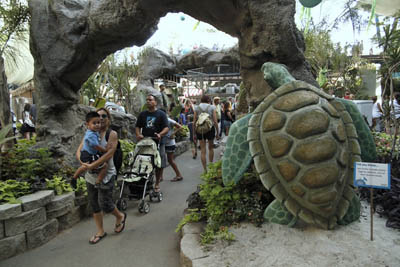 |
|
Family enjoying the Beach Buddy Adventure, Courtesy California State Fair
|
Add a splash of fun to your summer and learn more about our ocean by visiting "Beach Buddy Adventure" at the California State Fair from July 10-26, 2015. Enjoy frolicking otters, say hello to a tule elk, and learn about other coastal species and ways our inland behaviors affect creeks, rivers, and their coastal environments. Use a "Beach Buddy" map to earn your official "Beach Buddy Badge" by visiting various stations to explore environmental issues affecting the wildlife of coastal California. Talk with members of the Sacramento Regional Conservation Corps who have learned all about topics facing our ocean and our waterways. There's even a giant sandcastle where you can learn about beach sand and a lighthouse with a bald eagle ready for your visit.
This exhibit won a national award in 2014 is being sponsored again this year by a WHALE TAIL® grant
from the California Coastal Commission.
 |
|
Students from June Jordan School for Equity
|
Thanks to a WHALE TAIL® grant, students from June Jordan School for Equity, a small public school in San Francisco,
will have the opportunity to explore and investigate the nearby ocean and Bay. A science teacher
at June Jordan wrote and received a grant to buy supplies like microscope attachments and binoculars
and to bring biology students out into their local environment. Field Biology students in 9th and
10th grades were able to visit local wetlands, visit Candlestick Point, collect and classify oceanic
plankton, and do a beach cleanup and learn about human impacts on San Francisco Bay. Marine Biology
students in 12th grade kayaked in Elkhorn Slough to see wildlife up close and took part in a research
cruise with the Marine Science Institute, conducting different marine science activities and finally
getting to experience a boat ride.
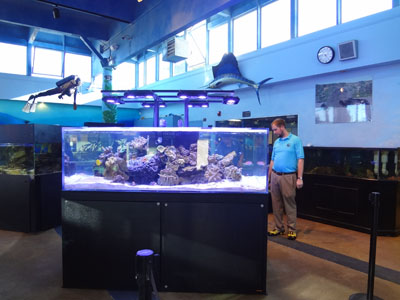 |
|
Cabrillo High School Aquarium
|
Whatever you're picturing a school aquarium looks like, the one at Cabrillo High School, near Vandenberg Airforce Base, is better than that. There are quite a few tanks, they're clean and beautiful, and the whole room looks very professionally put together. The entire aquarium is largely run by students, who do everything from animal husbandry and maintaining water filtration systems to teaching visiting elementary students from Lompoc (in northern Santa Barbara County) and hosting public open houses. My guides are two head curators, Ashley and Jacob (plus their faculty advisor, Chris Ladwig). Ashley is doing her senior project on creating two new tanks, the shark tank and the saltwater tank, where she's cultivated corals that are growing beautifully. Jacob loves "fun facts" and keeps them up at a steady pace: the flesh of the cabezon fish is green; decorator crabs stick small shells and pebbles onto their backs using their saliva as glue; the lines visible on a blue whale's chest are veins large enough for a human baby to crawl through. They also ask me some questions, like do I know what SCUBA stands for (I do, in fact).
I also see the classroom in the back, where earlier, fourth-graders spent half a day doing hands-on science
activities around a kelp theme that high school students prepared and led for them. The classroom will be
home to two wet lab stations that a Whale Tail® grant will help pay for so the high schoolers can hook
up salt water tanks and conduct their own marine science projects.
| — |
Sylvie Lee Grants Program Coordinator |
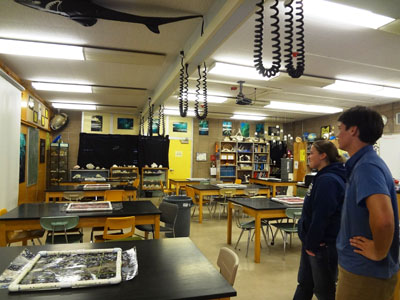 |
|
Cabrillo High School Aquarium Classroom
|
 |
|
Mattole Restoration Council staff in Petrolia
|
The Mattole Restoration Council works in California's remote "Lost Coast" and is headquartered in Petrolia, a town of around 500 people you can reach if you drive over an hour along winding, potholed, scenic Mattole Road from Ferndale in Humboldt County. If you stop at Petrolia's center and ask at the general store, you'll be directed to the town's only available office space upstairs from the community center. And there you'll find the knowledgeable, energetic MRC staff, who recently gave me a tour of their community and the work they do there.
MRC has a WHALE TAIL® grant for a Youth Environmental Stewards program being implemented through a
partnership of local organizations. Each month during the school year, students (the future landowners of
the area) at the different schools in the region get a classroom visit and a related field trip on a
series of topics on coastal and watershed health. For instance, they learned about salmon populations and
helped with a restoration project creating a cold water slough as a haven for migrating salmon. They
learned about marine debris and then cleaned up trash from Mattole Beach. This winter they'll learn about
nonpoint source pollution, visit local erosion sites, and study its impact on the Mattole Estuary. During
the summer, the WHALE TAIL® grant supported internships for young adults to work on watershed
restoration projects, as well as training for counselors at Lost Coast Camp to lead environmental
stewardship activities for their campers.
| — |
Sylvie Lee Grants Program Coordinator |
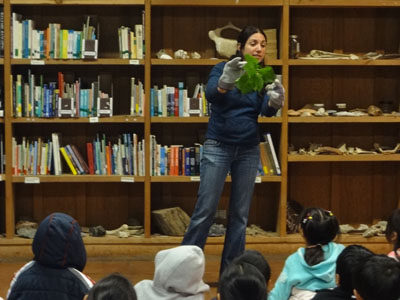 |
|
Fiona O'Kelly wears "poison oak gloves" to demonstrate plants to avoid.
|
Although rain was starting to fall, that didn't deter about three dozen students from Sutro Elementary in San Francisco from hiking down the hill as they arrived at the Clem Miller Environmental Education Center. They were excited to be starting their two-night visit at the Point Reyes National Seashore and they all settled down to hear an orientation from Program Coordinator Fiona O'Kelly (aka "Firefly"), who went over guidelines for their stay. The parts that seemed most crucial (like what to do if a bat gets in your cabin) were translated into Chinese by their teacher, and I learned a few things too—mice will nibble a fallen deer antler to get calcium; poison hemlock has formic acid just like red ants do.
By the time the students, their parents, and their dedicated teachers leave, they will have spent two days
here doing science field studies, capping off many lessons in their classroom beforehand. A WHALE TAIL®
grant to the Point Reyes National Seashore Association
is helping offset the program fees for this school and others like it, so they can afford to come and learn
at the wetlands, beaches, and hills of this beautiful and memorable spot on the California coast.
| — |
Sylvie Lee Grants Program Coordinator |
 |
|
MLK Jr. Middle School students enjoying the Marin Headlands.
Photo courtesy of YMCA Pt. Bonita. |
My Home, My Community, My World helps students connect with their local watershed, experience a visit to
the YMCA
Point Bonita, and realize that the ocean is in their own backyard. The YMCA received a WHALE
TAIL® grant to work with students from Marin City. Naturalists visited
their schools—Bayside Elementary and MLK Jr. Middle School—and 4th graders spent a day at a nearby beach
and a day at the Marin Headlands, 7th and 8th graders kayaked on Richardson Bay, and 5th and 6th graders
had the biggest adventure of all. They toughed out a six-mile hike (with gear!) straight from their
neighborhood, over the ridge behind them (where many had never ventured), and down through the Golden Gate
National Recreation Area until they arrived at the ocean for a three-day outdoor education program at the
YMCA. Throughout these experiences, all students were learning about the bay, the ocean, coastal
ecosystems, and the importance of taking care of their surrounding environment.
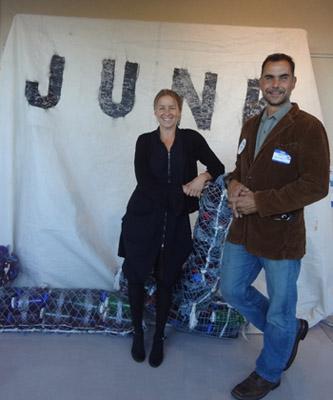 |
|
Anna Cummins and Marcus Erikson, 5 Gyres Co-Founders
|
Faces formed from melted plastic; a cast of a pregnant woman's body; large jumbled fishing nets—this is not your typical art exhibit or your typical educational content. But this creative collection has been put on display by 5 Gyres, which received a WHALE TAIL® grant for a traveling exhibit about the impacts of pollution in the world's oceans. The faces tell the story of plastic pollution through images of people who have contributed to the field of research on this issue; the pregnant body formed from ocean plastics illustrates the impacts of plastic chemicals on our bodies and unborn children; and the jumbled fishing nets remind us that they keep killing wildlife when they're left floating in the ocean. These pieces are part of "Saving Our Synthetic Seas," on exhibit at the Seed Gallery in San Francisco's Presidio until 11/8/13.
The grant for 5 Gyres is supporting other projects too, including developing a "plastic pollution report card"
for different California beaches (based on the amount of plastics found in the sand), assembly programs in
schools, encouraging some of those schools to become "waste free," and a student art contest. For more
information and a short video of the exhibit, please visit 5gyres.org/education_and_exhibits.
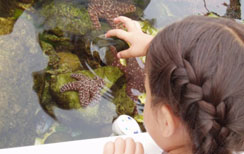 |
|
Photo courtesy of the Los Angeles Conservation Corps
|
There's much more to the Los Angeles Conservation Corps' Sea Lab in Redondo Beach than you might think at first. At first, you might think it's a nice little aquarium with a big classroom in the back, and you'd be right. Indeed, there are tanks with different types of sea life in it, and you can walk around and look at them and learn about them, and they're pretty neat, including some giant clams and a tropical tank of corals that it turns out are acquired when they're seized by customs agents (!). But if you get to tour the facilities behind the building, you'll see much more going on. There are touch tanks (I learn shark skin feels like sandpaper), a tank of seriously large bass (rescued, like other fish here, from the once-through cooling systems of power plants), flounders that look just like a floor of sand until you start spotting their eyeballs, a whole project growing green abalone (they're beautiful), a lab run by Algalita Marine Research Foundation studying plastic samples from the oceans, a native plant nursery for coastal habitat restoration projects, and a separate building dedicated to teaching students about water resources.
I'm here because the Sea Lab has a WHALE TAIL® grant to support
the Key to the Sea program, which teaches elementary students about watersheds, the storm drain system,
pollution prevention, sandy beach habitat, and environmental stewardship. Young adult Corpsmembers not
only host hundreds of school children on their educational field trips, they're also recruiting their
former elementary schools to participate and they're learning how to lead workshops educating teachers
about ocean life and marine conservation. As with the other programs here, the Corpsmembers work toward
getting a high school diploma while they also work on environmental improvement projects and learn
aquarium-related skills that help them find jobs later on.
| — |
Sylvie Lee Grants Program Coordinator |
 |
|
Students use an underwater "Fish Cam" to view sea life in the kelp beds.
Photo courtesy Crystal Cove Alliance
|
Helping meet the Crystal Cove Alliance's goal to "preserve the past, enjoy the present, and educate for the future" is a program series called "SNAP!—Science and Nature at the Park." Serving students and the general public, SNAP! includes a wide variety of programs at Crystal Cove State Park in Orange County including public exhibits and lectures, "Scientist in the Park" open houses, Marine Protected Area research cruises, classes on the beach for students with disabilities, and science instruction in a laboratory and on the water.
To help support SNAP!, a WHALE TAIL® grant funded a pilot program
for Marine Protected Area citizen science cruises. Over 200 students went on seven offshore boat trips
and used microscopes to count fish eggs and plankton larvae they collected; used fishing rods specially
equipped with a camera and a monitor to view and document the different types of fish living in the kelp
forest under their boat; and collected water samples to measure temperature, pH, and salinity. The
grant also supported 120 high school students attending an ocean acidification lab. Besides covering
costs for these students, funding was also used for purchasing digital microscopes, underwater cameras,
and other equipment to use in future citizen science cruises. Finally, funds supported the design of
interpretive panels educating the public about whales and other marine mammals.
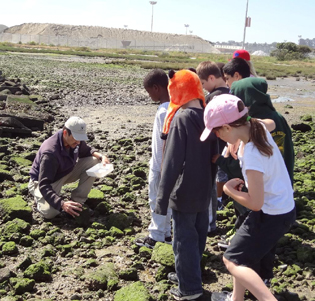 |
|
Low tide at San Francisco's Pier 94, with Golden Gate Audubon
|
"Pretend you're a bird flying in the air," Anthony DeCicco, Education Director for Golden Gate Audubon is saying as I arrive. "You're flying and you see this green patch. What is it?"
"California!" comes one hopeful guess.
"It's Pier..." cues DeCicco.
"94!" comes the answer.
The green patch on the map he's holding is indeed Pier 94, and I'm there on a sparkling spring day after
navigating past a whole slew of noisy trucks in an industrial area in southeast San Francisco. He's sitting
with a group of maybe 18 third-graders from nearby Flynn Elementary, and they're overlooking a wetland at
low tide near the bottom of Islais Creek that used to be a dumping ground before Golden Gate Audubon began
restoring it. After they listen to this history, learn about how the pollution harmed wildlife in San Francisco
Bay and the Pacific Ocean, and get an overview of local wildlife and what they're going to do today, they break
up into three groups. I go with the group that will be peeking under rocks where the tide has gone out. The
assignment is to look for crabs and isopods, determine the gender and appearance of the crabs, and use a key
to identify them. A boy named Jermaine is definitely not excited about this, but in less than five minutes he
is jumping and whooping and yelling, "We found a big one! We found a big one!" (His schoolmate Jamal, who
is also definitely not excited about this, will end up proudly showing me what he collected too.)
 |
|
Golden Gate Audubon's Anthony DeCicco
with Flynn Elementary students |
Emma needs a partner, so I get to be her partner. Emma is wearing a pink baseball camp and she is excited about this activity. She loves handling the crabs and picking up the crawly isopods (think really big pill bugs with lots of legs moving very fast), which is my ideal kind of partner. I handle the collecting tray.
Other groups are exploring the wetland, removing litter, and using a spotting scope and binoculars to conduct a bird census. There are Canada geese, a curlew, and an osprey with a nest on top of a large industrial crane. We see a goose family with fluffy babies float by.
I have to leave at lunchtime, but one of the last things I do is taste a salt marsh plant called pickleweed for
the first time. It tastes like salty grass—nothing like a pickle. Later on, students will be rotating activities
and installing some native plants to help improve the habitat. Before the school year is out, they will also
visit the upper end of the Islais Creek watershed (at Glen Canyon Park) and take their families to Muir Beach
to explore the ocean. It's all part of the Eco-San Francisco environmental education program funded in part by a Whale
Tail® grant.
| — |
Sylvie Lee Grants Program Coordinator |
 |
|
A front yard is transformed by the Ocean Friendly Gardens Program
|
The Surfrider Foundation's Ocean Friendly Gardens Program helps people apply CPR to their garden—Conservation, Permeability and Retention—to revive their watersheds and oceans. These environmentally friendly gardening techniques use less water, eliminate the use of chemicals, prevent or at least cleanse runoff, and create wildlife habitat. A Whale Tail® grant is supporting two Ocean Friendly Garden (OFG) education and training series—one in Santa Barbara County and one in Ventura County. Each series consists of five sessions: a Watershed Basics Class covering the fundamentals of CPR; a Hands-On Workshop in a highly visible garden to evaluate it for CPR and develop design ideas; a Garden Assistance Party to turn the garden into an OFG and post an OFG yard sign; returning to walk the neighborhood to identify gardens that could become ocean-friendly with a little help, or ones that are already eligible for a sign; and a special workshop for landscaping professionals.
The program keeps going even after the four workshops, because any recipient of a new garden agrees to serve as a model for the neighborhood and to "pay it forward" and help with creating another OFG in the future.
The series in both counties are underway this spring. To participate or to get more information, please contact Surfrider's
Ventura County Chapter or the Santa Barbara Chapter.
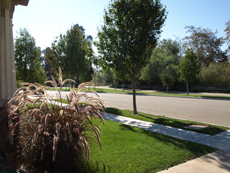 |
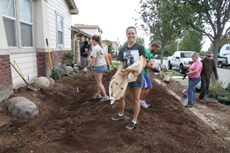 |
 |
|
Before
|
During
|
Catching Rain
|
 |
|
Sampling Pacific Mole Crabs at Fort Funston, San Francisco
|
On an unusually warm September day in San Francisco, teens from Thornton Continuation High School in Daly City descended on the beach at Fort Funston, planted rows of orange flags near the surf line, and began scooping up sand at each flag. They would then run up the beach to their classmates, rinse the sand away, and see what they were left holding. Quite often they were left holding small Pacific mole crabs. Having done this before, the teens knew how to measure them and determine whether they were male or female, and after marking down the relevant data, they would return the crabs to their sandy home and scoop up the next sample.
These students were participating in the LiMPETS program overseen by the Farallones Marine Sanctuary Association. "LiMPETS" is short for "Long-term Monitoring
Program and Experiential Training for Students." It is a hands-on science education program for middle
and high school students, who monitor either the distribution and abundance of the Pacific mole crab (an
important food web link on sandy beaches), or the distribution and abundance of 33 invertebrate and algae
species at specific rocky intertidal sites along the coast. After the data collection is complete, students
enter their information into the LiMPETS database, which is used by students as well as researchers to
track the populations of key indicator species over time. A Whale Tail®
grant is helping 1,500 Bay Area youth participate in this program.
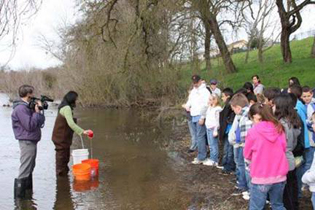 |
|
Tuolumne Salmon Fry Release
|
The Tuolumne River Trust operates the "Trekking the Tuolumne River" program which teaches elementary students in the Central Valley about the Tuolumne River, its value to the community, and how to be good stewards of the river. The program includes classroom activities, help in developing service learning projects, and hands-on activities at outdoor classrooms at the river to learn about watersheds, water quality, the riparian ecosystem, and the salmon lifecycle.
A grant from the Coastal Commission supported the addition of a coastal component to provide students with a more thorough understanding of the Tuolumne's connection to other rivers and the ocean. Students followed the journey of the salmon as they learned to trace the river on a map to the Delta and the Pacific Ocean, learned how river conditions effect conditions downstream, visited salmon spawning grounds during the fall migration, hatched salmonids in their classroom, released the salmon fry into the river, played games mimicking how salmon find their way back to the same river where they hatched, and traveled to the ocean to visit The Marine Mammal Center and Rodeo Beach in the San Francisco Bay Area.
This new coastal component was initially added at Salida Elementary School in Stanislaus County.
Their teachers received training so they could continue the program on their own. The Trust
intends to expand this new component into other schools in the future.
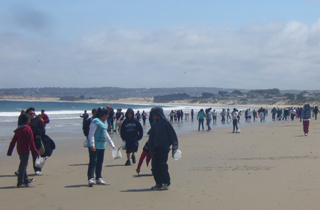 |
|
Fresno students at the Kids' Ocean Day Adopt-A-Beach Cleanup in Monterey
|
What do kids do when they step onto a beach for the first time? Some look toward the horizon, others watch the moving waves, quite a few marvel at how unusual it feels to walk on sand, and just about all of them enjoy it. Fresno Chaffee Zoo has been bringing Central Valley schoolchildren to the shores of Monterey since 2001, and for some of them, the trip is their first opportunity to visit the California coast. The Zoo's Education Department is able to do this through Whale Tail® funding for the Kids' Ocean Day Adopt-A-Beach Cleanup Program. Zoo staff visit participating schools in the spring, teaching students about marine life and the ocean environment and how their actions impact the health of the ocean, even many miles away. Then in the second part of the program, the students ride buses over 150 miles to do something about the pollution problem they've learned about.
In May of 2011, 185 fifth-graders from Carver and Yokomi Elementary Schools in Fresno picked up 4,600 pieces of litter
at Monterey Municipal Beach, which at first glance looked clean to begin with. What do some of them like best about
seeing the ocean for the first time? "Its beauty," said one student. "Being next to it," said another. Besides conducing
a beach cleanup, they also got time to play ball, dig for crabs, and find other ways to enjoy the sand and the water.
 |
|
Superpowers! exhibit at
Ty Warner Sea Center |
The Ty Warner Sea Center in Santa Barbara presented a one-year exhibit called Superpowers! It highlights local "superpowered" marine life of the Santa Barbara Channel, the "villains" that threaten them, and the ability of people to become "heroes" for the ocean through everyday actions
The exhibit is written in English and Spanish and starts with a superhero dress-up station where visitors can put on capes as they travel through the different stations. It is then divided into three areas:
The Sea Center is operated by the Santa Barbara Museum of Natural History. More information on this exhibit can
be found at www.sbnature.org/exhibitions/730.html.
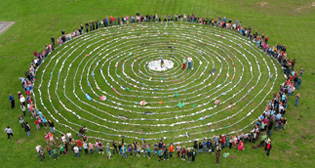 |
|
Arcata Elementary School's North Pacific Gyre Art Installation
|
In June 2010, the Arcata Community Recycling Center completed an art installation at Arcata Elementary School depicting plastic debris caught in the North Pacific Gyre. The school collected empty plastic bottles and arranged them on the playing field in a giant spiral, symbolizing plastic pieces swirling in the Pacific Ocean. Students also made sea animals which were shown entangled in the plastic debris. The installation was photographed from atop the ladder of an Arcata Fire Department truck. View a video of the project here.
A Whale Tail Grant funded this art project along with the accompanying education program, which included the bottle drive,
in-school lessons about the ocean and marine debris, beach cleanups, touring the Recycling Center, and recycling the bottles
afterward. The project was documented on video
by other students at Sunny Brae Middle School.
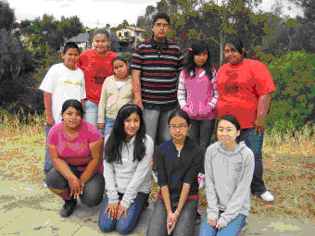 |
|
The Cesar Chavez Club organized a 'friends group' for
47th Street Canyon in City Heights |
The non-profit San Diego Canyonlands was awarded a Whale Tail® grant in 2009 to organize residents into "friends groups" to revitalize nearby, neglected canyon open spaces and restore the native habitats. They found a lot of energy from the youth groups in City Heights including the Hoover High School Eco-Club and the Cesar Chavez Club. The Cesar Chavez Club is taking on a leadership role in the campaign to restore open space canyons with creeks draining to the coast in the urban community of City Heights, San Diego.
Eight Club members helped with grassroots community outreach to establish a new canyon "friends group" at 47th Street Canyon in City Heights. On a Saturday morning in June they helped distribute flyers to promote a free guided tour in 47th Street Canyon. The students also distributed information encouraging people not to use non-native plants that take over natural habitats in the canyons and information on reducing the use of polluting chemicals and fertilizers in home gardens. The tour was held on June 27th and was a smashing success with 40 attendees. A new stewardship group for the canyon was established with strong and dedicated leadership. They now have routine monthly stewardship events in the canyon. The Cesar Chavez Club has continued to support the canyon group efforts.
Cesar Chavez said, "The only way I know how to organize people is to talk to one person, then talk to another person, then talk to another person." The flyers the Chavez club distributed brought the community together to talk about their neighborhood canyon, learn about the importance of the unique habitats in it, and now they collectively are transforming this open space into healthy habitat that is a safe, enjoyable community asset.